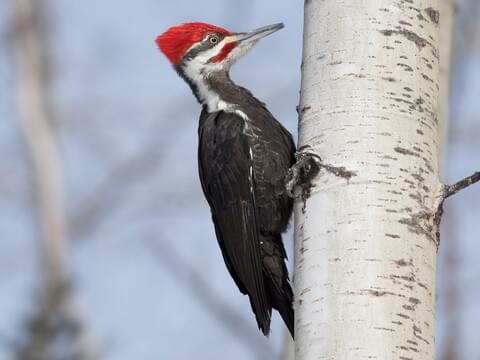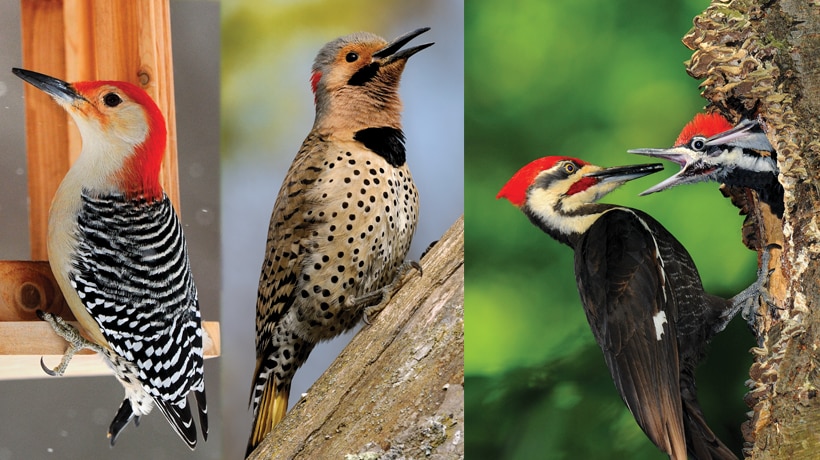Observing Woodpeckers in Florida: Variety Diversity and Circulation
Wiki Article
Woodpeckers Unleashed: Exploring the Wonders of These Experienced Tree Mountain Climbers
Woodpeckers, with their distinct markings and rhythmic drumming echoing via wooded areas, hold a special place in the avian globe. Their specialized makeup and adjustments enable them to browse vertical surface areas with unparalleled ability. However, their mastery of tree climbing is simply one aspect of their fascinating behavior. As we dive right into the intricate information of woodpeckers' nesting practices, feeding methods, and the continuous preservation initiatives to secure these exceptional birds, a deeper admiration for their place in nature unfolds.Makeup and Adaptations
When examining the makeup and adjustments of woodpeckers, one can observe remarkable functions that allow these birds to grow in their specialized eco-friendly particular niche. Additionally, woodpeckers have zygodactyl feet, with 2 toes facing onward and 2 facing backwards, giving a firm hold on tree trunks while they browse for food or drum for communication.Furthermore, woodpeckers have a distinct tongue framework that is long, barbed, and sticky, allowing them to extract pests from holes in wood. This specialized adjustment allows woodpeckers to exploit a food resource that is hard to reach to many various other bird species. In general, the anatomy and adjustments of woodpeckers showcase the remarkable evolutionary options that have permitted these birds to prosper in their arboreal environment.
Drumming Habits
Having explored the anatomy and adaptations of woodpeckers, the focus now moves to understanding their drumming behavior, a distinct element of their interaction and territorial display screens. Drumming is an important kind of communication amongst woodpeckers, serving numerous functions such as developing regions, bring in companions, and signaling alarm system. Each woodpecker species has a distinct drumming pattern that helps people acknowledge participants of their own types and differentiate them from competitors or predators.Woodpeckers produce drumming sounds by rapidly pecking on powerful surface areas such as dead trees, energy poles, or perhaps steel items, developing a series of rhythmic beats. The intensity and speed of drumming can vary based on the objective; as an example, a rapid drumming sequence might symbolize hostility in the direction of trespassers, while a slower and softer drumming pattern could show courtship (Woodpeckers in Florida). Furthermore, woodpeckers may change the frequency and period of their drumming to share details messages efficiently
Nesting Behaviors
Exploring the nesting routines of woodpeckers discloses fascinating insights into their reproductive habits and habitat options. Woodpeckers are recognized for their special nesting preferences, commonly digging deep into dental caries in trees to produce protected areas for raising their young. These dental caries serve not just as a nesting site but additionally as a secure haven from killers and harsh climate.Woodpeckers exhibit a high level of fidelity to their nesting sites, commonly returning to the same place every year. This actions highlights the significance of ideal environment This Site accessibility for their reproductive success. The selection of a nesting site is critical for woodpeckers, with aspects such as tree species, elevation, and degeneration phase playing significant functions in their decision-making procedure.
Interestingly, some woodpecker species are recognized to excavate several cavities within their territory, providing themselves with alternative nesting alternatives. This approach may serve as a form of insurance coverage versus possible hazards or disruptions to their primary nesting site.

Feeding Methods
Woodpeckers employ a range of specialized feeding strategies to acquire their primary food sources. Among the most distinctive feeding habits of woodpeckers is drumming, which involves rapid pecking on trees to discover Click Here insects beneath the bark. This drumming not only aids them situate target however additionally serves as a method of interaction with various other woodpeckers. Woodpeckers have solid, chisel-like beaks that enable them to pierce into wood effortlessly. When a hole is produced, they utilize their lengthy, barbed tongues to draw out bugs such as ants, beetles, larvae, and crawlers. These tongues are covered with sticky saliva that assists catch the victim. Woodpeckers are also known to dig deep into dental caries in trees to access hidden insect larvae or sap. Some species, like the acorn woodpecker, shop nuts in particularly produced openings called granaries. This tactical storing of food helps them make it through throughout food deficiency durations. Woodpeckers are truly exceptional in their feeding strategies, showcasing adaptability and knowledge in procuring their nourishment.Preservation Efforts
Among the intricate feeding techniques displayed by woodpeckers, the conservation efforts focused on guarding these interesting birds play a vital duty in protecting their environments and populaces. Woodpeckers encounter various hazards to their survival, including habitat loss due to deforestation, climate modification modifying their ecosystems, and accidents with manufactured structures such as buildings and automobiles - Woodpeckers in Florida. Guardians are actively functioning to resolve these difficulties and guarantee the lasting wellness of woodpecker species
Education and learning and public understanding projects are additionally essential elements of woodpecker conservation initiatives. By elevating recognition about the importance of these birds in keeping healthy woodland ecosystems, preservationists can garner assistance for environment conservation campaigns and promote responsible land management methods. Through collaborative efforts in between scientists, policymakers, and regional neighborhoods, we can interact to protect a future where woodpeckers grow in their all-natural environments.
Conclusion

Report this wiki page